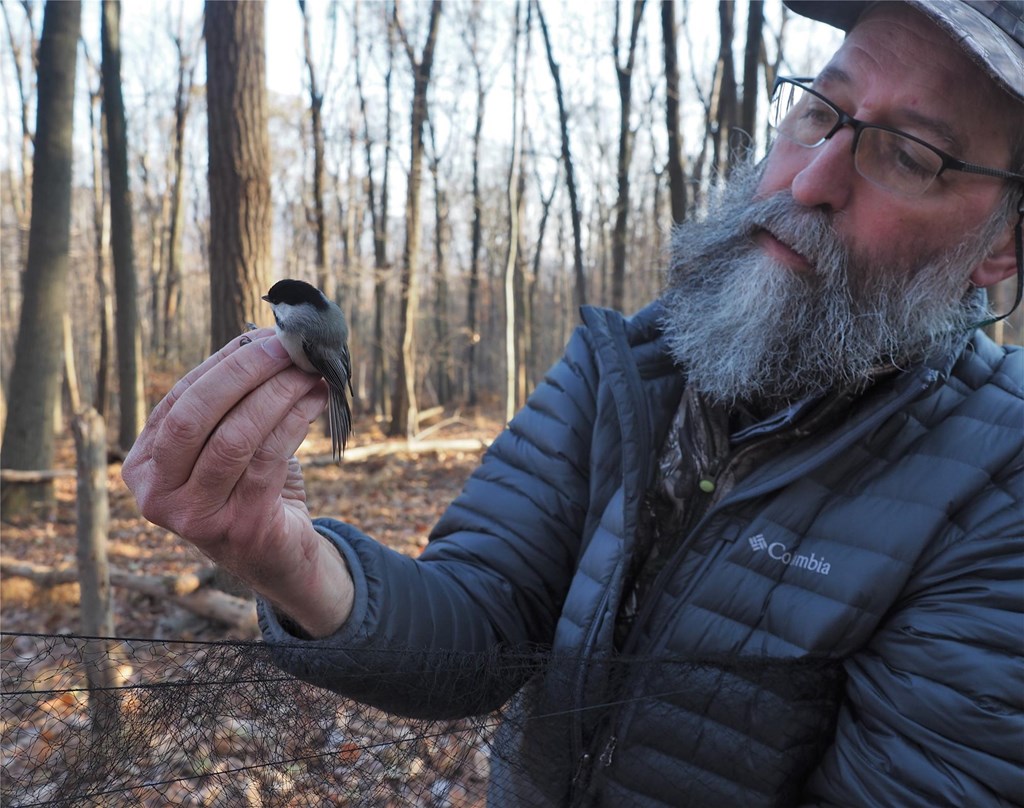Changing Chickadees
Posted on December 27, 2019 in Science

Changing chickadee songs might not raise an eyebrow for most people, but to ornithologists, this is indicative of a slew of other factors. Dr. Robert Curry, a professor of biology at Villanova University, is studying black-capped, Carolina, and hybrid chickadees while completing a research semester that has included time at Hawk Mountain’s Acopian Center for Conservation Learning. During a presentation to staff, volunteers, and conservation trainees, Dr. Curry shared the fruits of his and his associates’ research, explaining the causes and implications of growing hybrid populations among these species.
Black-capped and Carolina chickadees belong to mostly separate geographic ranges, with black caps across the northern U.S. as well as Canada, stopping before the Arctic Circle. Carolinas can be found across most of the Southeast, with their range ending partway through New Jersey and Pennsylvania, then continuing west until the Great Plains. In the northernmost parts of the Carolinas’ range and the southernmost of the black caps’, we see hybridization, and this hybrid zone continues shifting north as global temperatures rise.
In research that began in 1998 across a transect that includes four sites in southeastern Pennsylvania, Dr. Curry and his team have focused on the presence of hybrid chickadees, and on changes in population composition over time.
As part of his research, Dr. Curry and his colleagues placed snags made of long, hollow tubes throughout Hawk Mountain’s property for chickadees to nest in. This allows the team to study families as well as track individuals by banding and collecting samples of DNA.
Suitable site selection for snags is a skill learned over many years of field research, something Dr. Curry has no shortage of. After working with these birds for so long, he has learned that they like to fly into open spaces and that snags should not face trees or other dense foliage that would give predators easy access to the nest. House wrens are also a hazard as they will coopt the nests of competing birds, destroying the eggs and, sometimes, nestlings. Dr. Curry also knows that chickadees prefer that their nest cavities face downhill rather than up if placed on an incline. Of course, he notes, snag placement is a bit of a guessing game. Some are never claimed, and he couldn’t tell you why.
The snags have either a three-inch or four-inch diameter, with an opening no larger than 1 ⅛” to combat nesting by larger birds. The snags are filled with sawdust to encourage chickadees to excavate them and build their nests. The tops are removeable so that Dr. Curry and his associates can easily examine nests and collect the data they need, including clutch size, hatch date, and blood samples.
Blood samples are an especially important set of data, considering that hybrids are often indistinguishable from the two pure species. Also, looking at the two parents of a nest does not necessarily indicate the species of the young. Female chickadees mate between each egg that they lay, meaning a black-capped father could be guarding the nest and his fellow back-capped mate, but perhaps only one of the eggs were fathered by him. The rest could be hybrids born of various Carolina sires or other black cap males.
Using blood samples collected from chickadees at different sites, researchers can analyze the genome of these individuals and show movement over a decade. Genotyping by sequencing (GBS) allows scientists to look at many sections of a genome and scan for alleles (genetic variants) that differ from bird to bird. In doing so, they can note the frequency of Carolina or black-cap alleles in a given location, and the composition within populations of chickadees with different genotypes. These data show that there is an average shift north in favor of the Carolina alleles of 11.5 km per ten years. As time elapses, southern species of chickadee can live and breed further north, and the zone of hybridization advances as well.
This shift north is associated with changing climate. Different species of chickadee can tolerate a minimum temperature to survive the winter. As winters get warmer and areas further north can accommodate the metabolisms of southern birds, the more these species can expand north, breed, and compete for resources.
So, what does hybridization mean for these closely related species? Unfortunately for the chickadees, research shows that hybrid birds have lower survival rates, lower hatch success, and appear to be cognitively impaired compared with their pure-bred brothers and sisters. In tests requiring problem-solving skills and spatial memory, hybrid birds do not perform nearly as well as pure black-caps and Carolinas.
While these cognitive impairments have yet to be tested in the field, tests on captive birds could mean that hybrids are less suited to survive in their environment. Spatial memory is important for behaviors such as seed caching (hiding) and perhaps remembering the localities frequented by predators like sharp-shinned hawks.
As hybrid chickadees are identified in new locations, climbing to higher latitudes, we know that southern birds can survive where, decades ago, they would have frozen to death come winter. It is important to continue collecting these data and interpret the implications of hybridization, whether it be for genetics studies or a bigger picture: climate change and its effects on animal behavior, population abundance and range, and even biodiversity overall, by altering the competitive and reproductive relationships among species in natural communities.